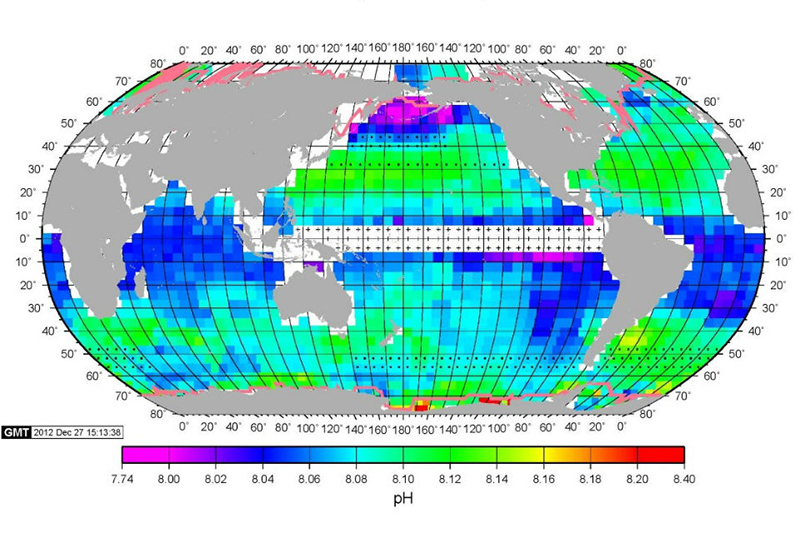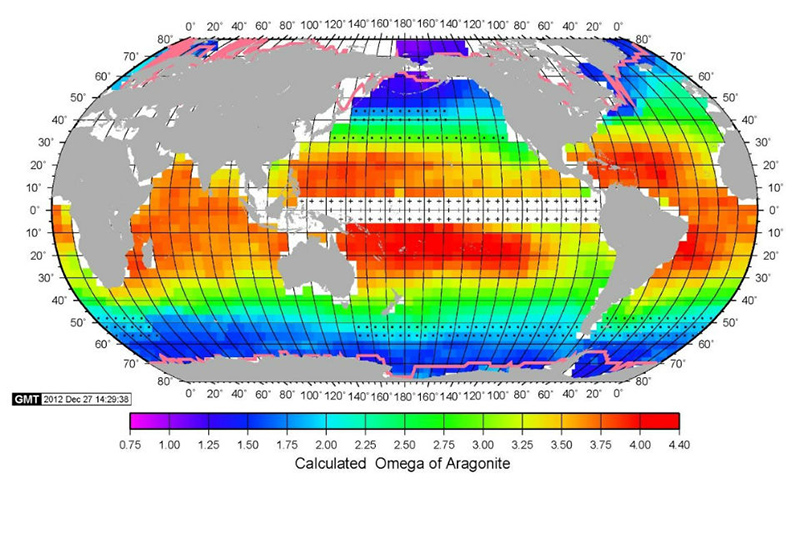February 20, 2015 – Since the Industrial Revolution began two centuries ago our oceans have absorbed a quarter of the excess carbon dioxide (CO2) humanity has been adding to the atmosphere. This has slowed atmospheric warming but comes with a price – ocean acidification.
We measure the base or acidic state of the ocean on a scale that chemists have been using for centuries. It goes by the name pH. The origin of the term “pH” is disputed but generally it is agreed to stand for the “power” of “hydrogen.”
When I was in high school we would dip litmus paper into different concoctions in the chemistry lab to measure their base or acid levels. If the paper turned blue or purple that meant its pH value was more alkaline or base. If it turned yellow or red it meant the pH value was more acidic. I used pH testing on my aquariums to ensure the chemical balance was right for my tropical fish. And if I went to the doctor for a checkup, he or she would have me provide a urine sample which a lab would test using the same pH scale.
The pH level of the ocean is an important measure of its health. Normally the ocean is more alkaline so a litmus paper dip in seawater produces a blue result. But there are subtleties in the values and a great deal of variation based on where you are on the globe when you test the water. In a new study from Columbia University the current state of our ocean acidity levels is revealed. Here are some notable facts:
- Tropical and temperate oceans currently have pH levels between 8.05 and 8.15 based on seasonal fluctuations.
- pH fluctuations are displaying more dramatic differences in polar regions because of a more dramatic variability caused by two things – seasonal change and deep ocean currents bringing CO2 laden water near the surface.
- The Indian Ocean is 10% more acidic than either the Atlantic or Pacific.
- Seawater as far north as Iceland and as far south as Antarctica is acidifying at a rate of 5% per decade.
- The current trends if they hold suggest by 2050 ocean acidification levels in temperate and tropical waters to be 25% more acidic than today.
- By 2100 if the trends continue a recent United Nations report calculates the impact of ocean acidification at $3 trillion U.S. a year to the global economy.
The map below plots 2005 data displaying winter Northern Hemisphere values for the world’s oceans. The most acidic region appears purple – the Bering Sea between Russia and Alaska. The equatorial Pacific appears blank because of highly variable conditions caused by El Nino and La Nina events.
A second map from February 2005 shows saturation levels of aragonite across the world’s oceans. Without aragonite shell-building animals would be compromised and corals would be unable to build reefs. The data displays red in the South Pacific indicating a high concentration of aragonite. And corresponding with higher levels of acidity, the polar seas appear blue indicating less aragonite.
The pink lines appearing on both maps delineate the approximate edge of the ice packs for both polar seas.
These maps are disturbing on so many levels. We are witnessing an unprecedented alteration in our oceans. Why is it unprecedented? Because the past geological record shows that ocean acidification levels have changed but not in time periods of a couple of centuries. Past alterations have occurred measured in thousands if not millions of years. And as we tackle climate change it is imperative that we recognize the importance of dealing with ocean acidification as well. If we don’t find a way to mitigate it the consequences to our existence and ocean life may prove unsustainable.
















